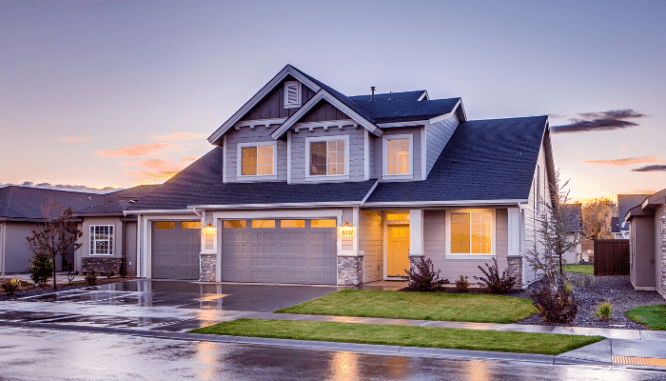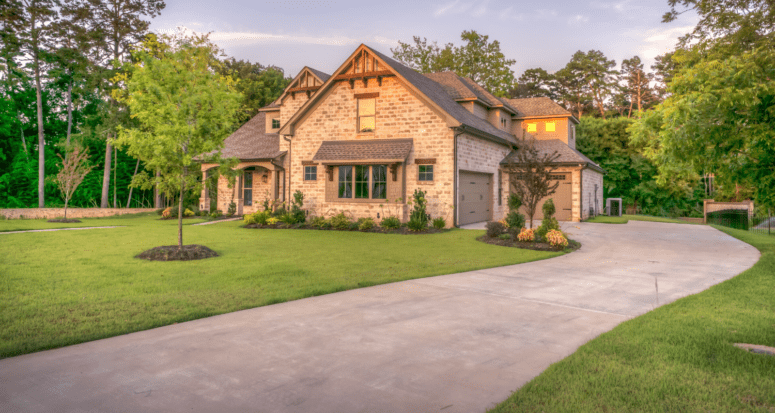Why Curb Appeal Is Important: You Only Have One Chance to Make a First Impression
- Published on
- 4 min read
-
 Michelle Nati Contributing AuthorClose
Michelle Nati Contributing AuthorClose Michelle Nati Contributing Author
Michelle Nati Contributing AuthorMichelle Nati has written DIY and home improvement articles for The Farmers’ Almanac, Apartment Showcase, and Hunker. She holds a B.A. in Communications and English from Niagara University.
We’ve all had the experience of driving or walking down a street and seeing a house that’s so adorable, we have to stop, stare, and imagine what it would be like to live there. The lawn is pristine, the flowers are always blooming, and the paint pops off the walls and trim. The house looks warm, inviting, and happy just to exist.
Meanwhile, the abode next door has a patchy lawn, toys strewn about the porch, and peeling paint, which makes things look… well, not quite so nice. Imagine if those two homes were for sale — even if the second one were bigger, do you think a buyer would jump as readily to make a high offer on it as he would the first?
First impressions last, and nowhere is this more evident than in real estate. If you’re listing your home, the initial impression it makes on a potential buyer can be the difference between a speedy sale and a house that languishes on the market for several months.

Defining curb appeal
Curb appeal describes the feeling a potential buyer has of a home as he or she approaches it, based on how it looks from the outside. In recent years, that initial impression has extended beyond the physical and into the virtual realm. How a home looks online can also greatly influence a buyer’s interest — in fact, in today’s highly competitive market, that’s where curb appeal really begins.
In a recent poll of top HomeLight agents from all over the country, 76% said that improving curb appeal was the best thing homeowners could do to boost a home’s marketability, and another 95% of agents confirmed that putting effort into cleaning and polishing the exterior can bring more attention and a higher value to that home.
We spoke to award-winning Columbus, Ohio agent Amy Clark about what makes curb appeal so essential, the little things some homeowners miss in prepping their properties for the market, and how you can make a big impression with a small budget.
Channeling a home’s ‘wow’ factor
Buying a home is an emotional experience. It is, therefore, critically important that a seller sets the proper stage in generating a positive emotional response from a buyer. Whether a buyer sees the property online or physically pulls up to it, they’re either connecting or not connecting with that property in those first moments. How it looks from the outside brings about expectations of what the inside looks like once they enter.
Curb appeal literally starts at the curb, and sometimes before it. Mailboxes, sidewalks, driveways, and aprons are the first things a buyer sees upon approach. If they’re looking at a cracked or broken driveway or sidewalk, or a mailbox that is tilted and rusting, it can significantly impact a buyer’s psyche, whether they are conscious of it or not.
Buyers and agents are looking at the big picture when viewing a home, but that doesn’t mean they are immune to the little details. Everything is taken into consideration from the moment they see the house, including the garage, the front door, the landscaping, and the outdoor light fixtures. Simple maintenance can add big numbers to a home’s value — according to HomeLight agents, upgrades like fresh mulch can increase ROI as much as 126%, and a lawn care service can add 352% more value. That’s just the tip of the iceberg!
But according to Clark, sellers often forget to address many of these things. “I’ve pulled up with buyers to homes in which we’ve seen missing window screens and broken shutters. As we get closer, we may see trim around the garage and front door with peeling paint. We can see that the yard isn’t well kept; the beds aren’t edged, or the plants are overgrown or dead. In those instances, I’ve found that sellers hadn’t prepared because they weren’t aware of it themselves.”
If you’ve already set a good impression with a home’s exterior, it will allow for a more hopeful expectation of what a buyer will see inside. However, if you set a poor example, any positive emotional experience you’re looking for becomes an uphill battle. No matter how beautiful the interior is, the mindset of the buyer has been influenced before they’ve even stepped in the front door. Neglect makes a mental shift in a buyer that says, “If the outside isn’t well taken care of, then I bet the inside isn’t either.”

Little things make a big impact
When addressing a home’s staging, Clark sometimes advises homeowners to forego their personal taste. Declutter your yard by picking up after kids and pets, and enlist the help of a friend, neighbor, or agent to give you a fresh perspective on anything you’re not sure about.
Keep your flower beds tidy and edged, and make sure your home’s trim is painted and its screens are repaired and in place. You can buy a screen repair kit for less than $10 from your local hardware store. If you need to replace the screen altogether, contact the manufacturer for a new one or build one yourself with a new frame and mesh.
A tight budget can be a big concern among sellers looking to make exterior changes, but it doesn’t need to be. You can have a home that looks as good as those in which significantly more money was spent on staging. Clark suggests the following affordable examples:
- Fixing tarnished or loose hardware. Tighten knobs, pulls, and knockers with a screwdriver, polish them, or give them a quick coat of paint. If you need to replace them, you can purchase separate pieces from a big-box retailer or hardware store for $10 and up. Full hardware sets can cost anywhere from $100 to more than $1,000 for custom-made pieces.
- Fixing or swapping out older light fixtures. Perhaps your exterior lights have been in place for years and are loose, tarnished, or don’t work at all. Polishing and painting lights is an easy job for beginners. However, if you’re replacing them all together and not doing the work yourself, you’ll average about $60 to $130 per light for parts and labor.
- Repairing or replacing shutters. Power wash, paint trim, and replace stiles on broken shutters. If the wood is too old or rotted, however, you may have to replace them altogether. Shutters range from $70 a pair at big retailers to about $500 for custom pieces.
- Give an old mailbox a new makeover. The mailbox is usually the first thing anyone sees when they approach a home, so make yours pop. Give it a deep clean to remove dirt buildup and cobwebs. When repainting it, go for sleek ombre, copper, or off-white colors, or match its scheme to your home. In warmer months, plant flowers at its base. You can also start fresh with a new one — mailboxes range in price from as little as $13 from a big-box retailer to $1000 for a more customized model.
Curb appeal in a winter wonderland
While most home sales start to see an uptick in the spring, there are still properties that hit the market during the coldest months of the year. Curb appeal is just as vital in those months as it is during the summer, according to Clark.
“If it snows heavily and you’ve scheduled an open house or showing, you’ll want to make sure potential buyers can pull up and get into the home. Snow shoveling and plowing creates the idea that the owner cares about their house. This makes the buyer think, ‘Maybe I should care about this house.’”
Before showing your home in winter, make sure buyers have easy access to your property. Take a trip to a hardware store to pick up a snow shovel (or if you’re feeling like you can really take on Old Man Winter, rent a snowblower) and put down a little rock salt or ice melt on the driveway and walkways to keep visitors from slipping. If you can’t remove the snow yourself, check Nextdoor — you’ll likely have a neighbor who can help with manpower or, if necessary, a snowplow.
While the northern states see their share of snow, more than often than not, there is little to no snow on the ground during the winter months in the midwest and southern states — it’s usually just cold and gray. Even when nothing is growing, your yard and home can still be neat, appealing, and approachable to buyers.
Add color to your front door with a non-seasonal wreath of grapevines, leaves, or floral accents for less than $50. You can also cover the area in front of your door with a simple mat made from straw or recycled materials, which will run about $30 to $40.

Creating virtual curb appeal
You can’t negotiate with a buyer if you can’t get them to the house, and if you don’t present the property online in a way that will compel someone to want to hop in their car and see it firsthand, there won’t be a sale.
A professional photographer is the icing on the curb appeal cake. As an example, if you have a protruding garage, you’ll want it to be in the background — you don’t want a house to look like it’s all garage in photos. A pro will know the best angles and lighting to use when shooting your home to drive traffic virtually and physically to it.
Even if you have a date set to shoot, the weather can intervene. Clark said, “I’ve met agents who, even if it’s not sunny, will shoot anyway because they want to stick with the date they’ve made. They’ll go out and do it themselves and end up with bad pictures. We use a professional photographer, and we’ll delay the listing to get the best photo possible. We want to shoot on a sunny day because you have one chance to hit the market, make an impression, and get the buyer to the house.”
Put yourself in the buyer’s shoes
Often, a realty company will have a stager they work with who can give you tips on how to increase your curb appeal to add value to your home. Clark and her team have one on staff who stages the exterior from the driveway, and she advises sellers to take a look at their property with fresh eyes. “Stand outside your house with your agent and look at it as if you were the buyer. If you were walking up, what would you notice?”
It always helps to have a second opinion on what your home’s exterior needs to spruce up its curb appeal. Talk to a top real estate agent in your area to get insight on what works best.
Header Image Source: (Pixabay / Pexels)
